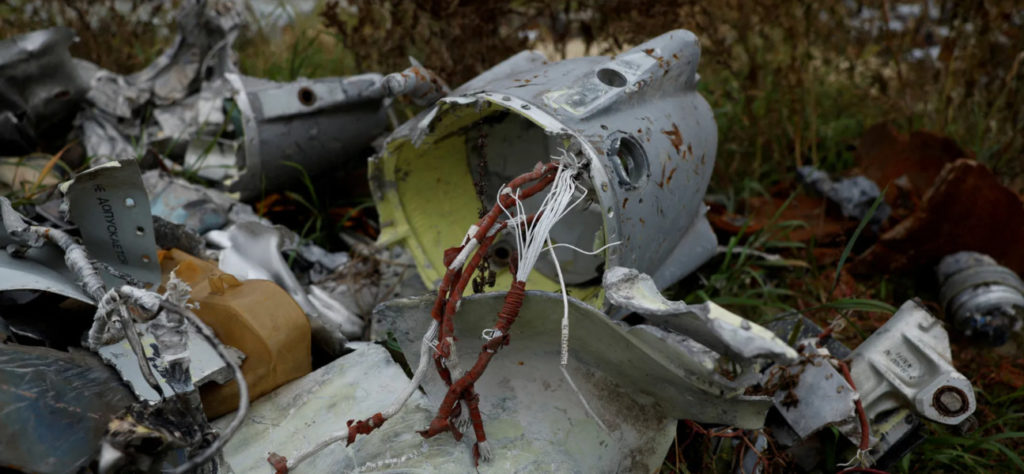An investigation about Inkotech, yet another supplier of contraband microelectronics for Russian weapons, infomrs iStories.
One of the deadliest Russian missiles is the Kalibr. For example, 27 civilians were killed in one strike in Vinnitsa and 29 in Kharkiv. At the beginning of the war, Russia had about 500 Kalibrs, and they were quickly shot down. But production continues, with 15-20 per month.
Like other Russian weapons, the Kalibr requires foreign electronic components. Where do they come from?
First, there is a stockpile — Russia was saving up imported components before the war. British Conflict Armament Research, which studied Russian weapons in Ukraine in the summer of 2022, claims that the Kalibr’s circuit boards are made from foreign components manufactured between 2012 and 2020. And second, imports of missile components continue today.
American Kalibr
One of the main parts of the Kalibr is the active radar homing head. It guides the Kalibr to the target at the end of its flight — it detects the target, determines its coordinates and transmits them to the missile guidance system.
Homing heads for the Kalibr and for other missiles (Kh-35, Kh-59) are made by Radar mms.
The enterprise was founded back in the 1950s — at that time it was called OKB-275 and dealt with short-range navigation and blind landing systems for airplanes, radar stations for ships, and others. Now one of the main products of Radar mms is control and guidance systems for high-precision weapons. According to the data for 2016 (the latest available), the main shareholders of the company were its general director and general designer Georgy Antsev and St. Petersburg businessman Alexander Kretov.
The company has been under US sanctions since the summer of 2022. However, as IStories found out, Radar mms still has access to the US microelectronics market.
Not just missiles
In the first year of the war, Radar mms paid almost 700M rubles (≈$7.5M at the exchange rate as of October 26, 2023) to the company Inkotech for components — diodes and microcircuits, according to documents at the editorial board’s disposal.
Inkotech specializes in supplying electronic components to Russia. The company’s website says that thanks to cooperation with “leading manufacturing plants in the United States, Europe and Southeast Asia,” it can provide uninterrupted supplies to Russia to “the largest enterprises of the military-industrial complex.”
Radar mms is not Inkotech’s only or largest defense customer.
For example, Kotlin-Novator paid more than 1 billion rubles (≈$10.65M) to Inkotech for components in the first year of the war. Kotlin-Novator makes avionics and includes itself “among the leading enterprises of Russia’s military-industrial complex.” The company is part of the Leninets holding of the Turchak family; according to the holding’s 2022 report, production at Kotlin-Novator increased 1.5 times.
Another Inkotech client, which bought 300M rubles (≈$3.2M) worth of components over the year, is the Scientific and Technical Center for Electromagnetic Warfare, the developer of the Pole-21 electronic warfare system.
This complex was adopted into service in 2016, was tested in Syria, and now jams Ukrainian drones and missiles using satellite navigation. The suppression radius of Pole-21 is about 150 kilometers. And it is difficult to detect them — they are designed so that they can be mounted on cell phone towers. It was due to the Russian electromagnetic weapons that Ukraine lost about 90% of its drones in the first year of the war — and lost its intelligence advantage.
The Central Design Bureau of Apparatus Engineering purchased 90M rubles (≈$959K) worth of components through Inkotech. It is involved in the production of radar stations for the Pantsir-S anti-aircraft missile-cannon system. For example, such a system is located on the roof of the Ministry of Defense building in Moscow. Pantsir also uses imported components.
Import helpers
Inkotech’s catalog includes components from such American manufacturers as Analog Devices, Marvell Technology, Texas Instruments, Xilinx, Holt Integrated Circuits and others. The company itself does not import them. It would be impossible: Inkotech directly declares itself as a supplier of the Russian military-industrial complex, and its co-owner Pavel Grishanovich has been in the U.S. Department of Commerce blacklist since 2012.
Therefore, Inkotech operates through intermediaries.
One of them is IQ Components. In the first year of the war, Inkotech bought 4.3B rubles (≈$45.8M) worth of electronic components from it. The owner of IQ Components is Alena Lugovtsova, who actually works at Kotlin-Novator — here she is as marketing manager thanking the organizer of her company’s stand at the International Aviation and Space Salon. The director of IQ Components is Maxim Vanyugin, who works at Inkotech itself.
IQ Components is one of the leaders in importing dual-use components to Russia, Verstka wrote. In 2023 alone, the company imported components worth 3.5B rubles (≈$37.3M), including American companies. In July this year, it did fall under sanctions, so imports ended. But this did not hinder Inkotech much, because it also has another intermediary — the company Trec. After sanctions were imposed on IQ Components, it increased purchases from Trec — they have already amounted to more than 0.5B rubles (≈$5.3M) since July.
Trec is actively purchasing components abroad: almost 1B rubles (≈$10.66M) worth in 2022 and already 600M rubles (≈$6.4M) in 2023. Who is behind the company? Most likely, Inkotech again: Trec’s phone number matches that of Olga Schenova, co-owner of Inkotech.
We did not manage to get comments from any of the subjects of this article. Kotlin-Novator, Inkotech, IQ Components, Radar mms and other companies ignored our questions. Birute Schneideris, general director of Trec, first wrote: “We will contact you,” but after receiving our questions, she stopped contacting us.

